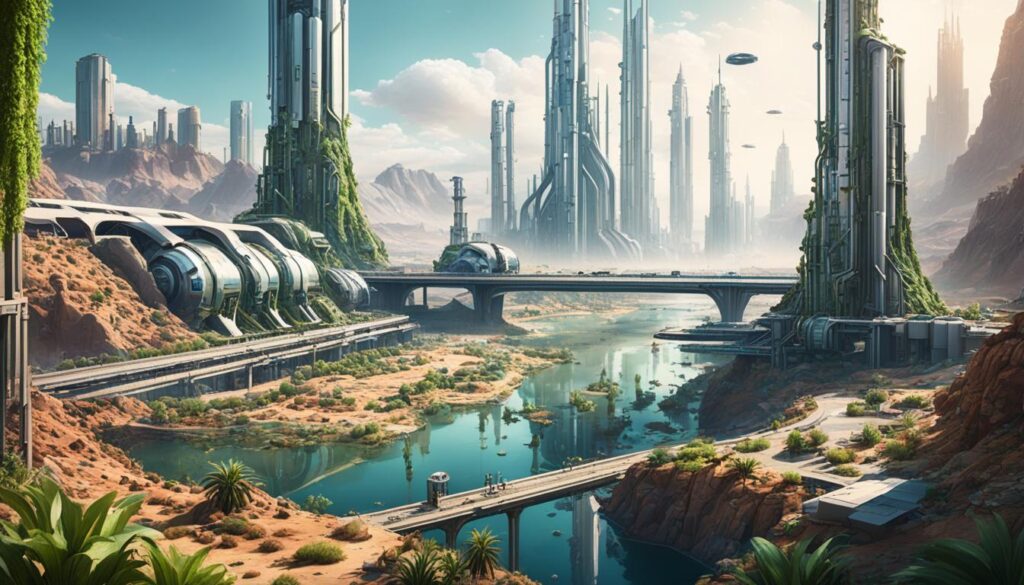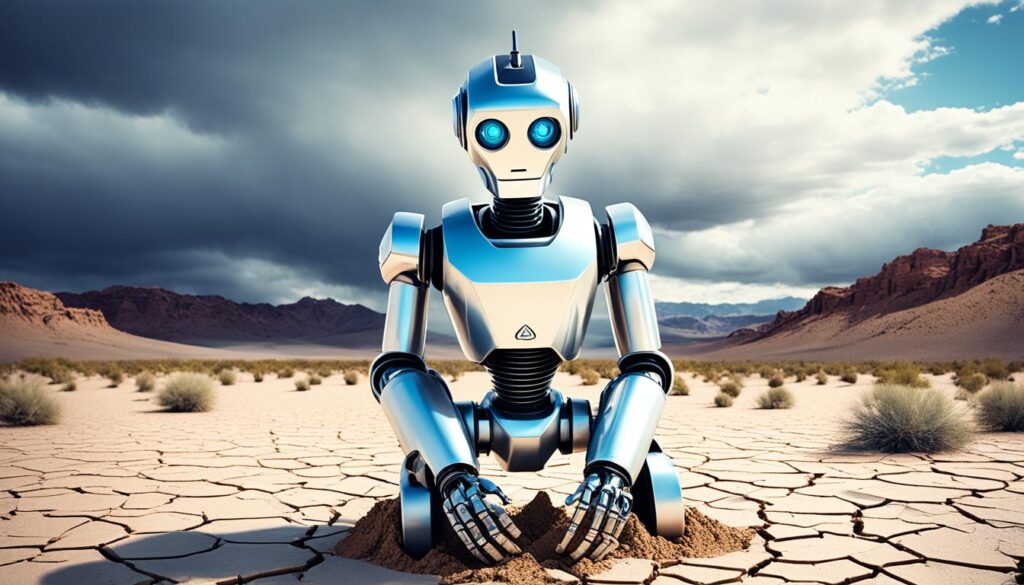Humans have already used up the safe amount of water on Earth. This has happened alongside seven of eight key Earth System Boundaries. This shows we urgently need to tackle the growing water scarcity affecting our natural and human worlds.
The world’s poorest areas still lack basic water and sanitation. Meeting these needs will put more pressure on our already strained water resources. Ironically, artificial intelligence (AI), seen as a solution to water issues, might actually make things worse because of its own water usage.
Key Takeaways
- Humans have already exceeded safe and just boundaries for water, putting natural and human systems at risk.
- AI’s potential in water management has grown, but its own water footprint is a growing concern.
- Data centers are major consumers of water, with usage expected to rise significantly by 2027.
- Developing countries face trade-offs between economic benefits and water resource strain from technology investments.
- Balancing AI’s water footprint is crucial for sustainable water management.
The Water Crisis and Its Boundaries
As the world deals with climate change, the water crisis is a major issue. Water scarcity affects many places, leading to big problems. We need to know the limits we must follow for a safe and fair earth.
Crossing the Safe and Just Earth System Boundaries
Experts have set eight safe and just limits for five areas (climate, nature, water, nutrients, and air). Going past these limits can harm people and nature, raising the risk of big changes. Sadly, we’ve gone over the safe limits for water. Now, the amount of surface water and groundwater being taken out is more than nature can replace.
Water Scarcity and Its Impact on the World’s Poor
The water crisis is getting worse, even though the basic water and sanitation needs of the poorest aren’t met. This puts more pressure on water resources. Global water inequality means some areas have plenty of water, while others have very little.
| Statistic | Impact |
|---|---|
| Water demand has increased approximately 40% over the past 40 years and is estimated to rise another 25% by 2050. | The increasing demand for water is putting a strain on existing water resources, leading to scarcity and competition for this essential resource. |
| Global GDP exposed to high water stress could increase from $15 trillion (24%) in 2010 to $70 trillion (31%) by 2050. | The economic impact of water scarcity is significant, with a growing number of regions facing high water stress that can hamper economic growth and development. |
| It would cost only 1% of GDP annually until 2030 to solve the global water crisis according to BofA Global Research. | The relatively low cost to address the global water crisis underscores the importance of prioritizing water security and accessibility, as the benefits would far outweigh the investment required. |
“Freshwater constitutes only 3% of the world’s water, with two-thirds of that being in glaciers or inaccessible for use.”
The water crisis is a big and complex problem that needs a global solution. By understanding the limits and inequalities, we can aim for a better and fairer water future for everyone.
AI’s Potential for Solving Water Problems
As the world faces growing water scarcity, there’s hope that artificial intelligence (AI) can help. AI is key in making water use more efficient and in monitoring water quality. It’s also changing how we handle irrigation and treat wastewater.
AI-Powered Solutions for Water Efficiency and Monitoring
AI-powered biosensors are changing how we check water quality. They can spot toxic chemicals in drinking water better than old methods. AI is also working with sensors and automation to create smart irrigation systems.
These systems use real-time data to manage water better. They help save water and find leaks quickly.
Smart Irrigation Systems and Wastewater Treatment
AI is making a big impact in farming by creating smart machines and sensors. These ai water solutions and ai for water management technologies help with irrigation. They adjust water based on soil moisture and weather, making farming more efficient.
AI is also promising for improving how we treat wastewater. For example, Indra Water can get up to 99% of wastewater ready for reuse. It uses 25% less energy than old methods. As water problems get worse, ai-powered water monitoring and ai wastewater treatment will be key to protecting our water.
“Combining human experience with AI technology will lead to better-informed decisions with higher confidence.”
– John P. Kmiec, Director of the Tucson Water Department
Artificial Intelligence Is Running Out Of Water
The global AI market is growing fast, expected to hit $91.18 billion by 2025. This growth is worrying because of the environmental impact, especially the water usage of AI.
Studies show that just 20 to 50 queries on ChatGPT can use half a liter or 17 ounces of fresh water. In 2021, Google’s U.S. data centers used 12.7 billion liters of fresh water to cool their servers. Training GPT-3 AI at Microsoft’s U.S. centers for two weeks needed 700,000 liters of fresh water. That’s like making about 370 BMW cars or 320 Tesla electric vehicles.
AI training in less efficient data centers in Asia could triple water use, making water scarcity worse. Experts urge big tech to cut AI’s water use. They suggest training AI during cooler hours to reduce water loss to evaporation.
As AI becomes more integrated into our societies, its water use will increase. This will worsen the ai water scarcity and ai drought issues. We need to find ways to manage the ai environmental impact of these technologies quickly.
“Between 2021 and 2022, Microsoft saw a 35% increase in water usage, using 1.7 million more gallons of water year over year.”
AI models like ChatGPT are growing fast, similar to Google’s rise. But their water use is very high. As AI evolves, we must find ways to reduce its impact on ai water scarcity.
AI’s Water Footprint
As artificial intelligence (AI) becomes more important, it affects the world’s water more too. The AI industry uses a lot of water in many ways. This includes the energy needed to cool and make data centers, and the water used to make AI hardware.
Water Consumption for Cooling and Energy Production
AI data centers are expected to use more energy by 2026. This could mean using 4.2 to 6.6 billion cubic meters of water by 2027. These data centers use a lot of water and let it evaporate, making it unavailable for a year.
This can put a strain on local water supplies, competing with people and businesses for water.
The Water Footprint of AI Hardware Production
Making AI hardware, like semiconductors and microchips, also uses a lot of water. This process involves mining for rare materials, which can pollute water sources. It’s estimated that training one AI model like GPT-3 could use as much as 700,000 liters of water.
This is as much water as several households use in a year.
Technology companies are working on making AI use less energy. For example, Microsoft wants to be carbon negative, water positive, and zero waste by the end of the decade.

As AI grows, finding ways to use it without harming the environment is key. This is especially important for the world’s limited water resources.
Data Centers and Water Demand
Our world is getting more digital by the day, making us rely on data centers more than ever. These places store the servers that keep our online lives running. They use a lot of water, mainly for cooling. The growth of data centers, driven by AI and other tech, is making a big impact on water use, especially in places where water is scarce.
Exponential Growth of Data Center Water Usage
It’s estimated that data centers might use between 4.2 and 6.6 billion cubic meters of water by 2027. This is because we want more AI and data-driven tech. For example, training an AI as smart as a human for a year could use 126,000 liters of water. And the power needed for AI grows by ten times every year.
Big tech companies’ data centers use more water than people think. Microsoft’s Dutch data center now uses four times as much water as before. Google’s centers used over 21 billion liters of water in 2022, which is 20% more than the year before.
The exponential growth of data centers means we’ll need more water for data center water usage and AI data center cooling. This will put a lot of pressure on the world’s water resources.
“Global AI growth projections suggest that the technology could require more water than some small nations consume.”
As technology keeps advancing, the water used by AI and data centers is becoming a big problem. We need to find ways to use water wisely to keep our digital world sustainable.
Conflicting Water Needs
The tech industry’s huge need for water is causing big worries. Communities are fighting back because their way of life is at risk. In The Dalles, Oregon, Google’s data center uses a lot of the city’s water. Taiwan uses most of the world’s advanced chip production and is trying hard to get more water, like through cloud seeding and desalination.
There’s a big debate worldwide about the economic benefits of tech investments versus the strain on water resources. Developing countries are especially caught in this tough spot. They must think about the economic benefits versus the risks of water scarcity and unequal access to water.
Protests Against Tech Companies’ Water Consumption
Tech companies’ growing operations are making people upset. In The Dalles, Oregon, locals are worried about Google’s data center and its big water use. This has led to protests and demands for more openness and responsibility from Google.
Geographic Inequality and Water Scarcity
Developing countries are really feeling the pinch of the water crisis. Places like the Middle East and North Africa have very little rain and lots of people. This means they struggle with getting enough clean water. In some parts of Central Africa, not having good water infrastructure makes things even harder.
| Statistic | Value |
|---|---|
| Percentage of freshwater used for agriculture | 70% |
| Percentage of freshwater used for industrial purposes | 19% |
| Percentage of freshwater used for domestic use | 11% |
| Projected drop in renewable water resources for every 1°C increase in global average temperature | 20% |
| People worldwide lacking access to safe drinking water | More than 2 billion |
| People worldwide lacking adequate sanitation services | More than half of the global population |

“The technology sector’s insatiable thirst for water has sparked growing concerns and protests from communities whose livelihoods are threatened by the industry’s water consumption.”
Balancing AI’s Water Footprint
AI is becoming more popular, and it’s making us worry about its effect on our water. AI can help solve big water problems, but it uses a lot of water itself. Experts say we need a complete plan to make AI use water wisely, so it doesn’t harm the environment too much.
One way to cut down AI’s water use is to use water wisely over time and place. This means training and using AI at different times and places to use less water. By doing this, companies can make AI use less water and support sustainable ai development.
Looking at how to make AI use less energy is also key. This includes finding new ways to cool AI systems, making data centers more efficient, and finding other water sources for AI. This helps make AI more energy efficient ai systems and green ai initiatives.
| Key Metrics | Impact |
|---|---|
| Training a large language model like GPT-3 | Can consume millions of liters of fresh water |
| Running GPT-3 inference for 10-50 queries | Can consume 500 milliliters of water |
| Estimated global AI demand by 2027 | May require 4.2 – 6.6 billion cubic meters of water withdrawal |
As AI grows, we need to know more about how it uses water. Knowing how much water AI uses helps us make better choices and support water sustainability. This way, AI can keep helping us without harming the planet.
“The challenge lies in balancing carbon and water efficiency in AI development. Exploiting ‘spatio-temporal diversity’ of water use efficiency could help reduce the water footprint of AI models.”
Conclusion
The water footprint of AI models and data is a big problem that needs quick action. AI’s growth is using a lot of water, which could make the ai water crisis worse. Companies must work on this issue, focusing on using water wisely and responsible ai deployment.
To make sure AI is used in a good way, we need to look at both its carbon and water use. This means being open about how much water AI uses and working together with tech companies, policymakers, and groups that care about the environment. This is key to lessen the environmental impact of ai.
As AI keeps getting more advanced, it’s important for the tech world to act fast to solve the water crisis. Using less water and new cooling tech can help. This way, AI can help everyone and protect our planet for the future.



